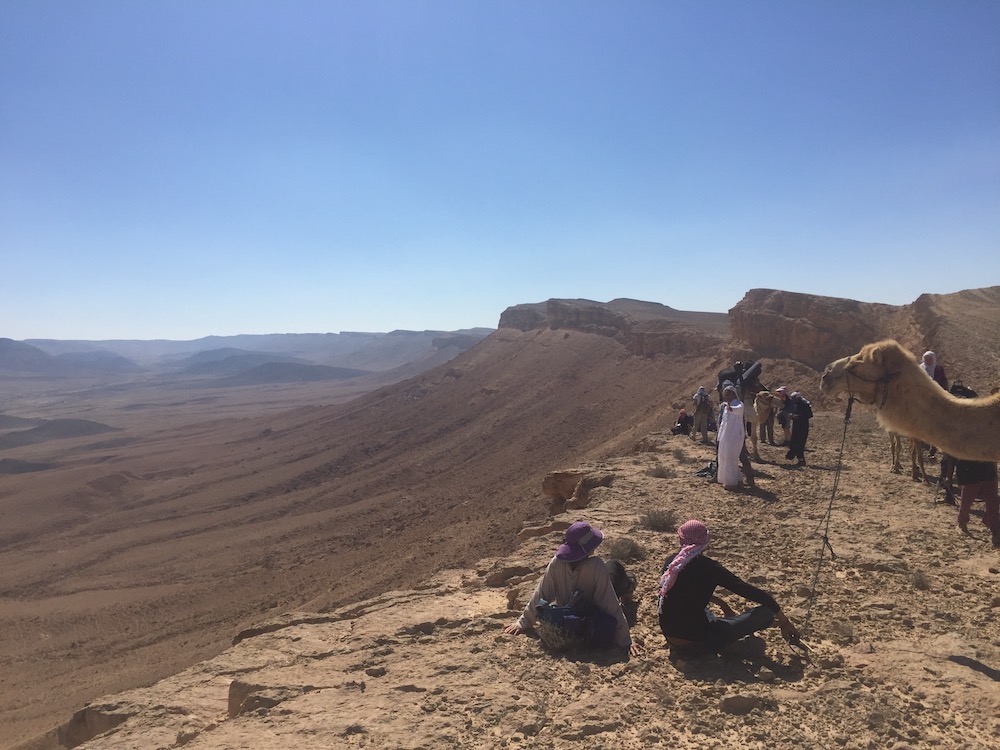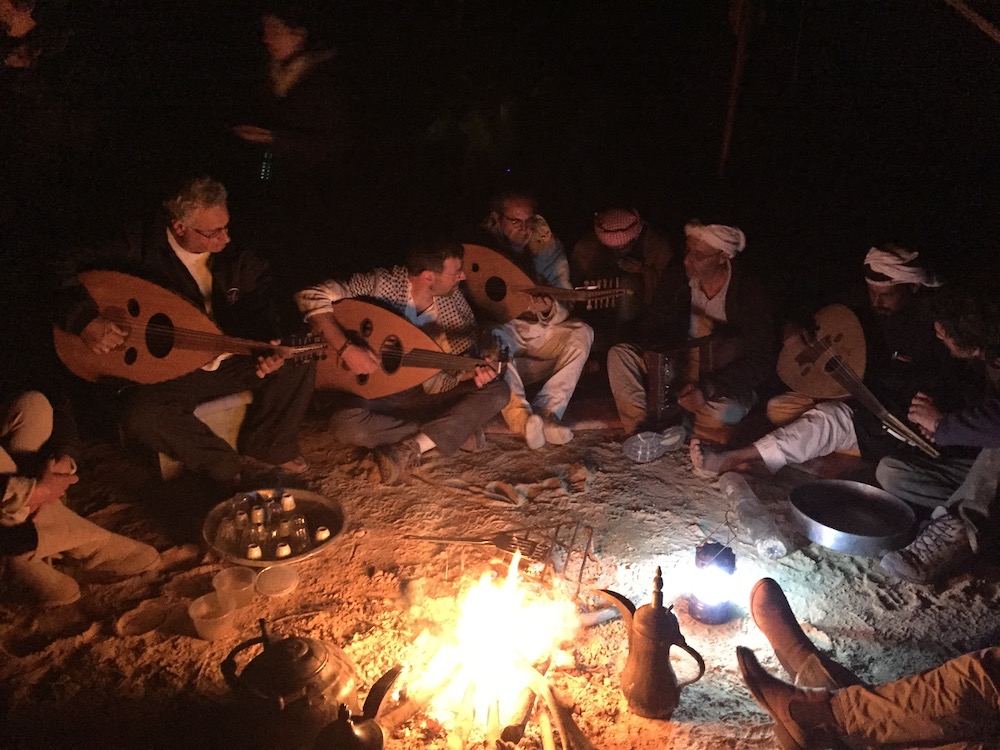Time Travel – Music of the Bedouins
/By Andy Teirstein
Musical Dromedary
Photo by Andy Teirstein
It begins with tying the musical instruments to one of the camels. Khaled makes a sound, like a chortle, and the camel kneels. Ouds and violins are strapped on. When the camel rises, it is a Picasso of instruments.
I have joined this journey from Ezuz, at the Israeli-Egyptian border, to Mitzpeh Ramon, Israel’s Grand Canyon, across the Aravah Valley of the Negev Desert. We are about fifteen people and several sherpa camels. The trek is the dream-child of the popular musician Yair Dalal and his Bedouin friend, Adel al-Walidi. Yair tells me they had the idea of making a hike to “fill the desert with music.” Our group is made up of musicians drawn from other parts of Israel and the local Bedouin community, many of them long-time students of Yair’s. Serving as both hosts and guides are Adel’s family: Khaled, Mahmoud, Abu Awad, Saeed, and the young boy Yaakub.
As we follow the camels into the open arid landscape, I begin letting go. Lingering unanswered emails evaporate in the sweeping heat, and a rhythm emerges, one foot in front of the other. These footsteps across the sand will measure the next four days.
Andy Teirstein in the Negev DESERT near Ezuz
Photo by Amir Shumel
As with everything in this part of the world, ancient history permeates our hike. According to Jewish scripture, Moses led the freed children of Israel through here several thousand years ago. They wouldn’t be the last nomadic tribes to walk this desert. We pass cisterns left by the Naboteans, an Aramaic culture prevalent here 2000 years ago. Today, Bedouin tribes live alongside small multicultural artist communities in Ezuz and Mitzpeh Ramon. But in our four-day hike we will encounter no other human souls, just the dust, rock, open sky, and an occasional wildflower of bright blue or red in a sand crevice. In this wilderness, world religions sprouted.
The journey from Ezuz to Mitzpeh Ramon
Photo by Andy Teirstein
Mitzpeh Ramon
Photo by Andy Teirstein
It’s hard to imagine this vast open land as a crossroads of any kind. But it’s the old paradox of desert life: We’re far from everything, but each traveler is also a central point in a 360 degree landscape. With their developed wisdom in water engineering, the Naboteans provided essential refreshment for merchants moving across three continents. Here, travelers far from their homes, representing an assortment of cultures and languages, sat and drank, broke bread, and shared stories. One can imagine the exchange of musical practices. I begin to see this hike as a symbol of the Translucent Borders endeavor, where the journey, not the destination, is the focus.
A break in the hike
Photo by Andy Teirstein
When the sun is high, a gnarley tree appears on the horizon. In its shade we spread a cloth and open a crate of dates. The camels rest, instruments are unstrapped; we gather tumbleweed and branches for a fire, and a lazy trickle of musical conversation stirs between the reclining travelers. Someone crushes coffee beans with a pestle, and soon the earthy coffee smell mingles with the modal music. A bag of flour is pulled from a camel sack, and a circle of people set to working the dough. I close my eyes, floating. Sleep comes, the sweet reward of the desert traverse. When I open my eyes I see Adel kneeling by the fire. He throws a pie of dough into the burning coals on the ground, covering it with smoking ash.
Lunch
Photo by Andy Teirstein
Soon we are sharing a delicious meal of humus, vegetables, and flatbread. I hear Arabic and Hebrew, relaxed laughter, and tunes drawn from the various maqams, the well of Arab music. A Maqam is analogous, in some ways, to a Western musical scale. But, as in Indian raga tradition, the concept of maqam is more fluid than that of the scale. It is not limited to the equal-tempered tones of Western music that developed to serve a keyboard-centered musical culture. Rather, the maqam tradition reflects the prevalence of the human voice, flutes, and bowed or unfretted string instruments such as the ouds played here. All of these instruments encompass quarter tones, the pitches that can’t be found on a piano, as they would live between the keys. Maqamat (plural) also resonate with character, sometimes reflecting the source places of a musical repertoire, such as Hijaz (Arabia), Kurd, or Saba (Sheba). The maqam is a pan-Arab cultural phenomenon, found throughout the Mideastern nations and in many other places across the globe. The concept is historically resonant in this spot, a point of nexus between the Persian musical culture to the east (and further, the ragas of India), and the African cultures to the west.
Oud player during lunch
Photo by Andy Teirstein
When we are once again hiking in our caravan line, the music lingers; there is singing as we walk. I pull a harmonica from my pocket and play along. Someone with a ukelele takes this as a cue to launch into American pop repertoire; he wants to hear Dylan songs. We strike up a blues melody. Then an Arab tune returns, which I try to learn on the harmonica. As he passes on his camel, Khaled throws a curious glance at the harmonica, briefly singing along.
Once in a while we pause and gather at some natural point of interest, and Adel shares insights about the ecology or history of the area. There are different tribes of Bedouin peoples. He tells us stories of tribal wars. One warrior was so fierce that another tribe went into deep hiding for years, only emerging at night to hunt and travel, developing special night vision.
Our hosts are of the Azazme Bedouin group. Their history is fraught not just with tribal wars, but with the ongoing struggle with the State of Israel for land rights. Bedouin people, like the Druze, are Israeli citizens who serve in the Israel Defense Force, often helping track smugglers at Israel’s Egypt border. Their ordeal is sometimes grouped as part of that of the Palestinian political spectrum, and sometimes viewed separately. Adel is well-educated, having studied geography at the Tel Aviv University. He knows the land from the perspective of ecology, history, and Azazme desert wisdom.
Saeed, with a camel
Photo by Andy Teirstein
The Azazme are sheep and camel herders. At one of our stops, Adel gives us a taste of camel lore, a humorous glint in his eyes. At the time of creation, all the animals were invited to choose their body parts, he tells us. The camel loitered in the desert, and only came to choose his parts after all the others had already taken the best ones. He was left with the head of a horse, the tail of a lion, the back of an elephant, and the hooves of a cow. Last, he was offered a penis, but it was very small. He protested, requesting to have the same one as a horse. Told that this was all that was left, the camel left indignantly. The creator threw the penis after the camel, and it landed backwards. This, Adel explains, is why the camel has a penis pointing backwards.
When the sun goes down, the burning heat of the day quickly fades. A breeze picks up, refreshingly cool at first, then suddenly cold. The work is now based around erecting a cloth enclosure to guard against the wind and building a large fire. The camels are set free to graze.
Tea and coffee are brewing; people are cooking. Music begins, different this time. Unlike the oud-based music played earlier, this music is made up of one short repeating phrase, lyrical and endearing. I hear something that sounds very much like an Appalachian lap dulcimer. It is a strummed instrument called a sumsumia that looks like a small harp, played by a man named Anad. I lie down in the sand close to the fire. Again, my horizontal pose induces a feeling of both release and connection. My eyes are filled with more stars than I ever imagined one could see, with an occasional spark from the fire entering my field of vision. And the music’s sweet phrase turns over and over, the melodic equivalent of patience, of understanding, of companionship. Over the next few days this music becomes a colored thread that weaves everything together. I try to learn some of the tunes, and to explore what it is that makes it so compelling to me, beginning with the sense of time. The sumsumia lays down an underpinning of constant eighth-note chords. Around the fire, people sing, often in even half-notes, a simple melody. I learn that this kind of Bedouin tune is called a Hjennie, a song of the camel drivers. The easy tempo of the singing is like someone walking, while the instrumental accompaniment is fast and patterned, as if carrying the singing. I can imagine camel drivers making up these tunes, singing them over and over on their desert crossings, for comfort. It brings to mind the American nature writer Edward Abby describing how he would sometimes make a small “comfort” fire in the desert.
Evening jam with Yair Dalal (center with oud), Anad Maneizi and other musicians
Photo By Andy Teirstein
And then three men stand. They link arms and begin a bouncing dance that happens only in the upper body; the feet don’t move. They seem pleased. Standing in their long robes by the fire, mustached, with heads covered, they are one bobbing unit, a string of smiling puppets. After a half-hour or so, I think, “Here is a dance I can do,” and I join them. I find their rhythm and their joy, leaning against one another. The dance puts us in an altered state, like getting high. Occasionally a deep-throated sound comes from the men, the same chortle Khaled gives to the camel. Now, in rhythm, it sounds to me like a snicker. And I realize it’s humorous. This is a kind of musical clowning.
Yair Dalal, the primary force behind this desert musical hike, sits next to Anad at the fire. His oud sounds clear, resonating among the other instruments, but also unobtrusive, as if the instrument is listening. Yair devotes his life to supporting and preserving various authentic musical traditions, beginning with his own heritage, and singing for peace. An Israeli-born son of Iraqi refugees, he grew up speaking Arabic, and identifies himself as an Arab Jew. He lived for a while in nearby Kibbutz Samar, close to the Bedouins and their music. Yair’s musical journey as a violinist, oud-player and composer led him to rock, jazz, classical, and Indian musical influences. In 1994 in Oslo he performed his song Zaman el Salam (Time for Peace) with a choir made up of both Palestinian and Jewish children, in Hebrew and Arabic, at the anniversary of the ill-fated peace accord. For Yair, music is a spiritual event, and his deepest experience of that brings him back to the desert. He named his first CD Al Ol, which is what the Bedouins say to their camels when they want them to rise and start moving. In 1999 he recorded an album in a Bedouin tent. He titled it Azazme. On the last day of our trek, Yair told me he is building a multicultural Music Center for Peace at Kibbutz Samar. It will be a place that combines musical study with organic date farming, with the goal of “bringing together different peoples and cultures in our region.”
Saeed, Khaled Abu Hasan (Rebaba), Yair Dalal (Oud), and Anad Maneizi ( sumsumia)
Photo by Andy Teirstein
The last part of our hike brings us to a dirt road and a kind of ranch. The camels are led into corrals. Before we say goodbye, we gather once more in a circle, and the music begins again.
A day later, I’m back in New York. I find myself out of step with the city. The buildings and onslaught of upbeat, polished, and sexy advertisements are like a grand hallucination. I hold a small rectangle in front of my face to read the time. Every once in a while I catch myself remembering those long moments in the Negev Desert by the fire. I’m drawn most to the Bedouin tunes. But listening to Yair’s wonderfully wrought CD is not the same. The music is there, the same songs, but I know now, more than ever before, how profoundly sound is wedded to place.
Anad Maneizi playing the sumsumia
Photo by Andy Teirstein
I’m reminded of an old folk tale. A traveler goes into a deep forest. In the darkness of a thick glen, he sees something shining—rare gems, a treasure. He gathers what he can carry and arduously makes his way back to civilization. But the moment he leaves the forest his sack contains only ashes.
Yaakub Wailidi
Photo by Andy Teirstein













